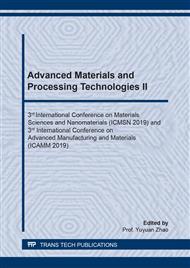p.98
p.106
p.115
p.121
p.128
p.135
p.143
p.151
p.159
Flat Metal Rolling Simulation by Finite Volume Method
Abstract:
In Thailand, the sheet metal products that were produced by rolling process have high demand and the consumption trend to grow in the future. Many new products, which made from rolling steel sheet, had been developed with various design. Thus the manufacturers have to improve the productivity through the investigation and analysis of different process parameters, which affect to the quality during the production. In this paper, finite volume method FVM had been applied to analyze different effects of processes parameters such as temperature, roller speed, friction, size and capacity of rolling machine. The commercial software MSC.SuperForge was used in the modeling and simulation of metal deformation under the flat rolling process. Considering the predicted results compared with the experimental data, the different in dimension error data were within an acceptable range of quality specification. The error in width of finished steel sheet was 1.17%, the length was error of 1.50%, and the thickness was error of 2.32%. By using this technique, different factors affected during rolling process can be investigated and controlled such as the metal flow, the distribution of stress and strain, and the deformation zone.
Info:
Periodical:
Pages:
128-134
Citation:
Online since:
March 2020
Authors:
Price:
Сopyright:
© 2020 Trans Tech Publications Ltd. All Rights Reserved
Share:
Citation:


